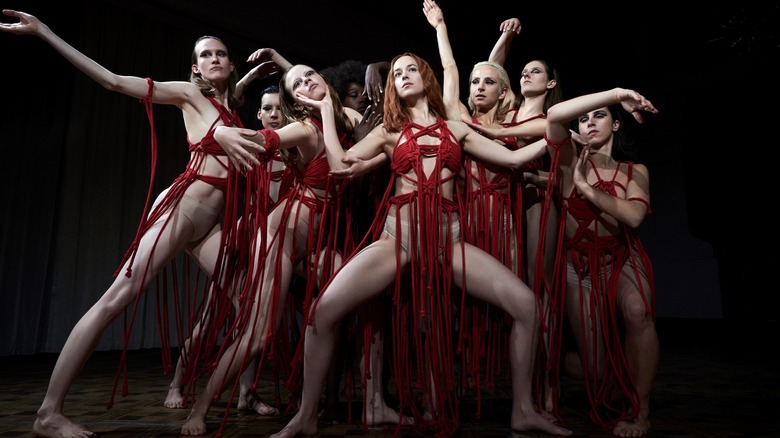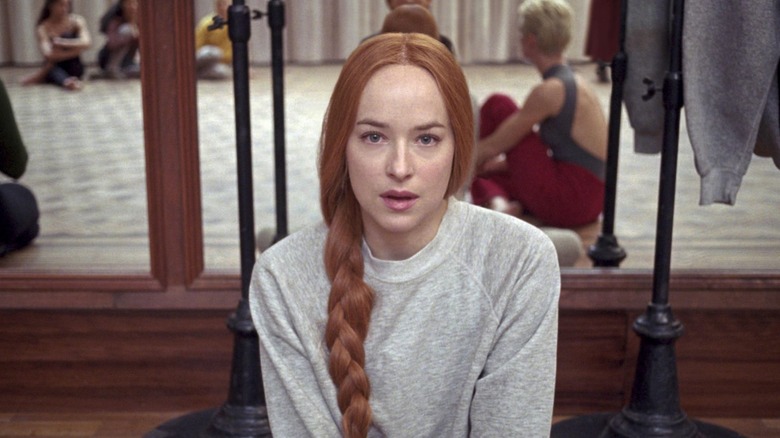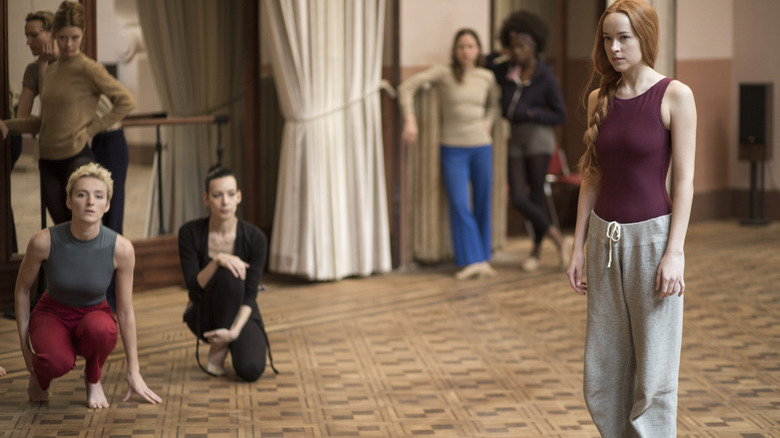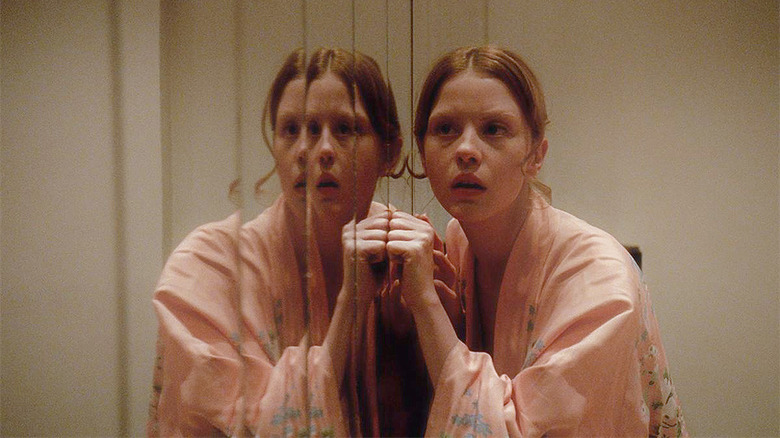Suspiria Was A Grueling Shoot For Dakota Johnson
The running list of actors who were psychologically impacted by major roles just got its latest member — Dakota Johnson. Johnson isn't known for being a tortured artist or a Method actor, meaning that she draws from her own experiences to deliver a performance. However, this is not to say her acting doesn't take a mental toll, as all actors must teeter the line between fantasy and reality. And when working on a film as mind-bending as "Suspiria," it's hard not to walk away scarred.
"Suspiria" (2018) is a remake of a 1977 cult classic from Italian filmmaker Dario Argento. The basic story, about supernatural happenings at a dance academy, is the same, but "Call Me By Your Name" director Luca Guadagnino creates his own unique spin, particularly on the film's horror and aesthetics. Suzy, an inexperienced but talented American dancer played by Dakota Johnson, travels to Berlin from Ohio to audition for her favorite dance company. The lead dancer Patricia (Chloe Grace Moretz) has just left, having gone totally insane, so Suzy is able to join the company and move into their dorm right away.
The lead choreographer Madame Blanc (Tilda Swinton) tells everyone Patricia left to join a group of political dissidents, but her therapist (also played by Swinton) and an old friend at the company (Mia Goth) grow convinced that there may be another cause for her disappearance. As it turns out, Patricia's delusions aren't delusions at all, and the dance academy is in fact run by a coven of witches.
The dance sequences were intense
The remake pays plenty of homage to the 1977 version, but it is "not trying to imitate or be a parasite of the original," as Guadagnino told Flickering Myth. The remake's color palette is more subdued than Argento's bright, Technicolor original film, and the setting needed to reflect that. Rather than use the original film for aesthetic reference, Guadagnino draws from the German cinema of the 70s, like the work of Rainer Werner Fassbinder. The key difference between the original and the remake is the incorporation of dance, moving into the realm of grotesque body horror. Guadagnino "felt that dance needed to be part of the process of witchcraft." Consequently, the choreography in "Suspiria" had to be powerful enough to cast a spell.
Johnson took ballet classes as a child, but trained with German Expressionist dancers for a year before filming and continued to train before and after shoots during production. A couple of months prior to filming, Johnson, Goth, and the other dancers trained directly with choreographer Damien Jalet in preparation for the film's various dance numbers. Johnson describes the choreography to W Magazine as "sexual in an animalistic way ... in an aggressive, exploratory way." She describes her character as "feeling an unearthly pull from the center of her body." Channeling this sensation created additional layers of difficulty and intensity to the choreography.
The subject matter took a psychological toll
On top of the exhaustive physical demands of the film, the film's themes of manipulation both real and supernatural are bound to weigh heavily on the minds of any performer who successfully channels their character's emotions. The film ultimately took a toll on lead actress Dakota Johnson, who "no lie ... had to go to therapy," according to an interview with Elle. She later clarified her comments later in EW:
"I'm a very porous person and I absorb a lot of people's feelings. When you're working sometimes with dark subject matter, it can stay with you and then to talk to [my therapist] about it afterwards is a really nice way to move on from the project."
"Suspiria" is about allowing your body to be used as a vessel, and this theme is bound to hit close to home for actors, who are vessels for their characters. It doesn't take a Method actor like Marlon Brando to draw from genuine emotions in order to produce an authentic performance. However, it often does require a close working relationship with a director. Luckily, Johnson and Guadagnino had collaborated before in the 2015 drama "A Bigger Splash." Johnson spoke to the creative rapport they had built in an interview with Hey U Guys, explaining that the actor-director duo "create a safe environment to do very extreme things," essential for making a film as extreme as "Suspiria."
In the end it was all worth it
The strain of the performance is not to mention the environment where the film was shot, which was challenging in and of itself. "Suspiria" was shot "in the deep winter, at the top of a mountain in an abandoned hotel where there was no central heating," the director told Flickering Myth. Johnson told W Magazine that being in the hotel gave her "crazy nightmares." One of the crew members was even injured — "it was a dangerous set," Johnson said.
Ultimately, though, the pressures of the shoot paid off. The actresses had "such an intense time filming it," as Johnson puts it, but ultimately felt "so wild and passionate about it" that "to see it in final form is really a feeling of accomplishment." When describing his favorite moments of horror in the film to MTV UK, Guadagnino pointed out that "everything we've described comes from the incredible power of performance of these wonderful actresses." Johnson and the rest of the impressive cast are instrumental in delivering the many moments of nail-biting suspense and gore that make "Suspiria" such a singularly twisted film.



